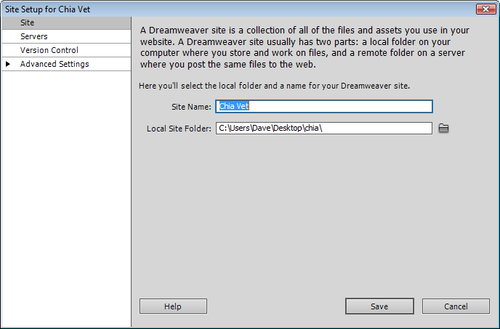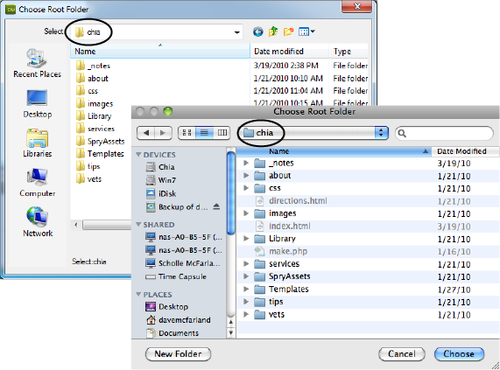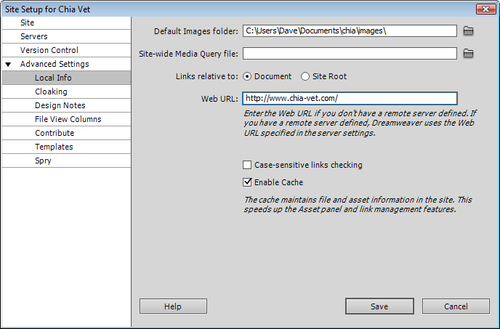|
Whenever you build a new website or want to edit one
that you created elsewhere, you have to introduce Dreamweaver to it—a
process called setting up a site. This is the
most important first step when you start using Dreamweaver, whether you
plan to whip up a five-page site, build a 1,000-page online store, or
edit the site your sister built for you. At its most basic, defining a
site lets Dreamweaver know where you store your web pages on your
computer, and makes sure Dreamweaver correctly inserts images and adds
links to the pages of your site. In addition, if you want to take
advantage of Dreamweaver’s many timesaving site-management tools, such
as the link checker , Library items , templates , and FTP tool for moving your files to a web server, you have to set up a site. There
are a lot of ways to configure a site, depending on your needs. For
example, if you’re ready to move pages to the Web, you need to tell
Dreamweaver how to connect to your web server. But you only need to do a
couple of things to get started using Dreamweaver effectively: Choose Site→New Site to open the Site Setup window (see Figure 1). You only need to provide a couple of pieces of information. Type a name for your site. The
name you type here is solely for your own reference, to help you
identify the site in Dreamweaver’s Files panel; it won’t appear on the
Web. Click the folder icon to the right. The Choose Root Folder window opens, where you select a folder on your hard drive to serve as your local site’s main (root) folder.
You’ll store all of your site’s files—HTML documents and graphics, CSS
files, and other files that make up your site—in this folder.
Note: Another way to think of the local site folder: It’s the folder on your computer in which you’ll put your site’s home page.
Browse to and select a folder for your site’s files. Figure 2
demonstrates the process for Windows and Macs. If you’re editing an
existing site, select the folder that contains the site’s files. If
you’re creating a new site, create a folder for that site using the New
Folder button in this window. 
For a few additional options, select Advanced from the left-hand list of setup categories (see Figure 3). This step is optional and you can happily skip it to begin building web pages. You’ll find most of the categories in the Advanced Setting category , but you may want to visit the options in the Local Info category: The Default Images
folder field lets you select (or create) a folder inside your site
folder to hold the images you’ll use on your web pages. Choosing an
images folder is useful only if you tend to add images from outside of
your site folder—for example, if you have images sitting on your desktop
or in another folder on your hard drive. If that’s the case,
Dreamweaver automatically copies those files to the images folder you
specify here. (Dreamweaver will still copy image files to your site
without setting this option, but each time you add an image from outside
your site folder, you have to tell Dreamweaver where to save the file.
If you’ll primarily use images saved somewhere in your site, skip this
setting.) 

Media
queries are a CSS-based tool that let you set up different formatting
rules for a page based on (among other things) the screen resolution of
the device used to visit your site. In other words, you can design a
site that displays differently on the small screen of a mobile device
(for example, it may show just a single column of content) than it does
on the much larger screen of a desktop browser (where you can fit, for
example, a three-column design). Setting determines how Dreamweaver writes links to other pages in your
site, links to images in your site, and links to external files, like
Cascading Style Sheet files, Flash movies, and so on. Unless you’re an
experienced web designer, stick with the normal “Document” setting
here. Type the web address for your site in the Web URL box: for example http://www.chia-vet.com/.
If you don’t yet have a web address, you can leave this blank. In some
cases, you may need to add some more information after the domain name.
For example, the address for your website might look something like
this: www.somecollege.edu/~bob.
Or you might be responsible for maintaining just part of a larger
site—sometimes called a “sub site.” Regardless, just type the address
you normally type into a web browser to visit your site. For example, www.mybigcompany.com/marketing. Leave the “Case-sensitive links checking” box unchecked.
This is useful only when you have web pages and files on a Unix server
that allows files with the same name but different letter cases: for
example, HOME.html, home.html, or HoMe.html. Since Windows machines and
Macs don’t let you do this, you’ll probably never have a site that has
files named like this. Keep the Enable Cache box checked.
Dreamweaver creates a site cache for each site you set up. That’s a
small database that tracks pages, links, images, and other site
components. The cache helps Dreamweaver’s site-management tools avoid
breaking links, lets Dreamweaver warn you when you’re about to delete
important files, and lets you reorganize your site quickly. The only
reason to uncheck this box is if you have a really large website (tens
of thousands of pages and images) and you notice that Dreamweaver is
really slow whenever you begin to work on the site, move a file, change a
file’s name, delete a file, or perform one of Dreamweaver’s other “site
management” tasks. In that case, you may see a box saying “updating the
site cache” or “checking links” that stays open and prevents you from
using Dreamweaver for a minute or more—basically your site is so big
that Dreamweaver has to spend a lot of time keeping track of your files
and links.
Click the Save button to finish the site setup process. Your
site’s files (if there are any yet) appear in the Files panel. Now
you’re ready to create web pages and take advantage of Dreamweaver’s
powerful site-building tools.
Note: Dreamweaver lets you set up multiple
websites, a handy feature if you’re a web designer with several
clients, or if your company builds and manages more than one site. To
define an additional site, choose Site→New Site. You can then switch from one site to another using the Sites menu in the Files panel.
|